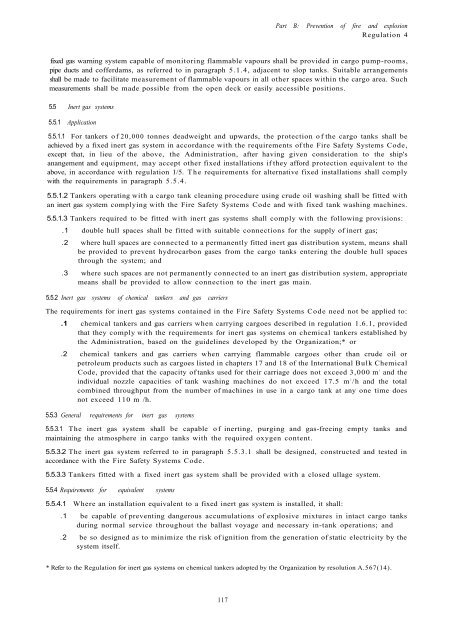Solas Consolidated Edition 2009.pdf
Solas Consolidated Edition 2009 for maritime
Solas Consolidated Edition 2009 for maritime
Create successful ePaper yourself
Turn your PDF publications into a flip-book with our unique Google optimized e-Paper software.
Part B: Prevention of fire and explosion<br />
Regulation 4<br />
fixed gas warning system capable of monitoring flammable vapours shall be provided in cargo pump-rooms,<br />
pipe ducts and cofferdams, as referred to in paragraph 5.1.4, adjacent to slop tanks. Suitable arrangements<br />
shall be made to facilitate measurement of flammable vapours in all other spaces within the cargo area. Such<br />
measurements shall be made possible from the open deck or easily accessible positions.<br />
5.5 Inert gas systems<br />
5.5.1 Application<br />
5.5.1.1 For tankers of 20,000 tonnes deadweight and upwards, the protection of the cargo tanks shall be<br />
achieved by a fixed inert gas system in accordance with the requirements of the Fire Safety Systems Code,<br />
except that, in lieu of the above, the Administration, after having given consideration to the ship's<br />
anangement and equipment, may accept other fixed installations if they afford protection equivalent to the<br />
above, in accordance with regulation 1/5. The requirements for alternative fixed installations shall comply<br />
with the requirements in paragraph 5.5.4.<br />
5.5.1.2 Tankers operating with a cargo tank cleaning procedure using crude oil washing shall be fitted with<br />
an inert gas system complying with the Fire Safety Systems Code and with fixed tank washing machines.<br />
5.5.1.3 Tankers required to be fitted with inert gas systems shall comply with the following provisions:<br />
.1 double hull spaces shall be fitted with suitable connections for the supply of inert gas;<br />
.2 where hull spaces are connected to a permanently fitted inert gas distribution system, means shall<br />
be provided to prevent hydrocarbon gases from the cargo tanks entering the double hull spaces<br />
through the system; and<br />
.3 where such spaces are not permanently connected to an inert gas distribution system, appropriate<br />
means shall be provided to allow connection to the inert gas main.<br />
5.5.2 Inert gas systems of chemical tankers and gas carriers<br />
The requirements for inert gas systems contained in the Fire Safety Systems Code need not be applied to:<br />
.1 chemical tankers and gas carriers when carrying cargoes described in regulation 1.6.1, provided<br />
that they comply with the requirements for inert gas systems on chemical tankers established by<br />
the Administration, based on the guidelines developed by the Organization;* or<br />
.2 chemical tankers and gas carriers when carrying flammable cargoes other than crude oil or<br />
petroleum products such as cargoes listed in chapters 17 and 18 of the International Bulk Chemical<br />
Code, provided that the capacity of tanks used for their carriage does not exceed 3,000 m 3<br />
and the<br />
individual nozzle capacities of tank washing machines do not exceed 17.5 m 3 /h and the total<br />
combined throughput from the number of machines in use in a cargo tank at any one time does<br />
not exceed 110 m /h.<br />
5.5.3 General requirements for inert gas systems<br />
5.5.3.1 The inert gas system shall be capable of inerting, purging and gas-freeing empty tanks and<br />
maintaining the atmosphere in cargo tanks with the required oxygen content.<br />
5.5.3.2 The inert gas system referred to in paragraph 5.5.3.1 shall be designed, constructed and tested in<br />
accordance with the Fire Safety Systems Code.<br />
5.5.3.3 Tankers fitted with a fixed inert gas system shall be provided with a closed ullage system.<br />
5.5.4 Requirements for equivalent systems<br />
5.5.4.1 Where an installation equivalent to a fixed inert gas system is installed, it shall:<br />
.1 be capable of preventing dangerous accumulations of explosive mixtures in intact cargo tanks<br />
during normal service throughout the ballast voyage and necessary in-tank operations; and<br />
.2 be so designed as to minimize the risk of ignition from the generation of static electricity by the<br />
system itself.<br />
* Refer to the Regulation for inert gas systems on chemical tankers adopted by the Organization by resolution A.567(14).<br />
117


